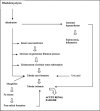Rhabdomyolysis updated
Abstract
Rhabdomyolysis constitutes a common cause of acute renal failure and presents paramount interest. A large variety of causes with different pathogenetic mechanisms can involve skeletal muscles resulting in rhabdomyolysis with or without acute renal failure. Crush syndrome, one of the most common causes of rhabdomyolysis presents increased clinical interest, particularly in areas often involved by earthquakes, such as Greece and Turkey. Drug abusers are another sensitive group of young patients prone to rhabdomyolysis, which attracts the clinical interest of a variety of medical specialties. We herein review the evidence extracted from updated literature concerning the data related to pathogenetic mechanisms and pathophysiology as well as the management of this interesting syndrome.
Keywords: Rhabdomyolysis; acute renal failure; crush syndrome; myoglobin.
Figures





Similar articles
-
Rhabdomyolysis Leading to Acute Kidney Injury.J Coll Physicians Surg Pak. 2021 Feb;31(2):235-237. doi: 10.29271/jcpsp.2021.02.235. J Coll Physicians Surg Pak. 2021. PMID: 33645199
-
[Muscle crush injury and crush syndrome].Medicina (Kaunas). 2010;46(6):435-41. Medicina (Kaunas). 2010. PMID: 20944453 Review. Lithuanian.
-
Dialytic treatment of rhabdomyolysis-induced acute renal failure: our experience.Ren Fail. 2001 Mar;23(2):183-91. doi: 10.1081/jdi-100103490. Ren Fail. 2001. PMID: 11417950
-
Rhabdomyolysis associated acute renal failure - Report of two fatal cases and a brief review of literature.J Forensic Leg Med. 2020 Apr;71:101941. doi: 10.1016/j.jflm.2020.101941. Epub 2020 Mar 12. J Forensic Leg Med. 2020. PMID: 32342911 Review.
-
Rhabdomyolysis secondary to influenza a infection: a case report and review of the literature.N Am J Med Sci. 2015 Mar;7(3):122-4. doi: 10.4103/1947-2714.153926. N Am J Med Sci. 2015. PMID: 25839005 Free PMC article.
Cited by
-
Clinical features of and risk factors for rhabdomyolysis among adult patients with dengue virus infection.Am J Trop Med Hyg. 2015 Jan;92(1):75-81. doi: 10.4269/ajtmh.14-0343. Epub 2014 Oct 27. Am J Trop Med Hyg. 2015. PMID: 25349377 Free PMC article.
-
White collar rhabdomyolysis with acute kidney injury.Indian J Nephrol. 2016 Nov-Dec;26(6):449-451. doi: 10.4103/0971-4065.177209. Indian J Nephrol. 2016. PMID: 27942178 Free PMC article.
-
Rhabdomyolysis aggravates renal iron accumulation and acute kidney injury in a humanized mouse model of sickle cell disease.Free Radic Res. 2023 May-Jun;57(6-12):404-412. doi: 10.1080/10715762.2023.2269313. Epub 2023 Dec 26. Free Radic Res. 2023. PMID: 37840281 Free PMC article.
-
Protective effect of quinacrine against glycerol-induced acute kidney injury in rats.BMC Nephrol. 2017 Jan 28;18(1):41. doi: 10.1186/s12882-017-0450-8. BMC Nephrol. 2017. PMID: 28129740 Free PMC article.
-
Creatine-kinase- and exercise-related muscle damage implications for muscle performance and recovery.J Nutr Metab. 2012;2012:960363. doi: 10.1155/2012/960363. Epub 2012 Jan 11. J Nutr Metab. 2012. PMID: 22288008 Free PMC article.
References
-
- Warren JD, Blumbergs PC, Thompson PD. Rhabdomyolysis: a review. Muscle Nerve. 2002;25:332–347. - PubMed
-
- Singh D, Chander V, Chopra K. Rhabdomyolysis. Methods Find Exp Clin Pharmacol. 2005;27:39–48. - PubMed
-
- Guis S, Mattei J-P, Cozzone PJ, Bendahan D. Pathophysiology and clinical presentations of rhabdomyolysis. Joint Bone Spine. 2005;72:382–391. - PubMed
-
- Criddle L. Rhabdomyoysis. Pathophysiology, recognision, and management. Critical Care Nurse. 2003;23:14–32. - PubMed
LinkOut - more resources
Full Text Sources
